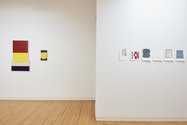John Hurrell – 19 February, 2019
Through its use of Corflute it becomes art that is not art but “ART”. Conceptually (not visually) it pumps itself up by relooping its own symbolic processes through its choice of a material rich in associations of ‘signage.' It proclaims and underscores its own cultural contrivance as an artefact.
With 50 works on paper (under glass) and 5 braced Corflute paintings, current Melbourne resident Rohan Hartley Mills shows us how he does his compositional research for wall works which mostly break away from the rectangular format. Although he clearly presents two quite distinct categories, the works on paper—though finished items in their own right-often have tensions in their layout dynamic which point the way to possible future elaborations involving Corflute (cut sheets of corrugated plastic).
Though strongly improvisatory, as the exhibition title suggests, the works on paper (that have a potential for further rearrangement) are also often sparked off by encounters with objects in ‘the real world’—like a couple of 40-gallon drums, a decrepit dartboard, or a grid of packing tape on a carboard box lid. Much as say Ellsworth Kelly used to do with drawings of arched bridge reflections or leaf shapes he made in Paris-that he later transmuted into shaped canvas works.
Rohan Hartley Mills‘ framed works on paper however have a linear fineness in their delicate detail that is missing from the larger corflute paintings. They are angular, spindly and intricate while the ‘simpler’ ribbed Corflute works mostly emphasise shape through blocks of translucent colour, and tease out asymmetry.
The paintings on white paper sometimes work within rectangular fields—with small, very understated marks—so dramatically sharp edges are not involved, as with the projecting Corflute-fronted panels which have a texture of vertical parallel lines. The latter are clearly objects projecting out from the wall. Sometimes they have horizontal rectangles cut into the front surface so that physical (as well as illusional) planar depth is observed, and internal panels at the back also painted.
Corflute is often used for real estate signage but not always. It (being light and strong) can for example also be used for protecting packages of travelling artworks. Interestingly its allusion to realty signage introduces a strange wit about abstraction itself and its production: coding that references its own signifiers as pleasure-inducing marks that are supremely self conscious. It is art that is not art but “ART”. Conceptually (not visually) it pumps itself up by relooping its own symbolic processes through its choice of a material rich in associations of ‘signage.’ It proclaims and underscores its own cultural contrivance as an artefact.
John Hurrell



















 Two Rooms presents a program of residencies and projects
Two Rooms presents a program of residencies and projects Advertising in this column
Advertising in this column



This Discussion has 0 comments.
Comment
Participate
Register to Participate.
Sign in
Sign in to an existing account.